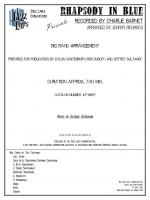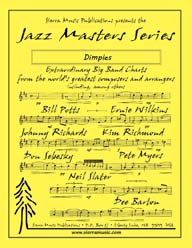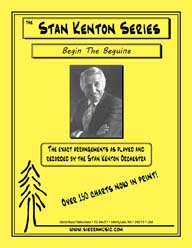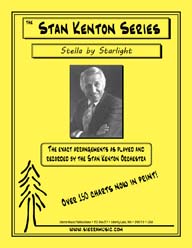RHAPSODY IN BLUE [DOWNLOAD]
Recorded by Charlie Barnet
Arranged by Johnny Richards, Prepared by Dylan Canterbury, Rob DuBoff, and Jeffrey Sultanof

Cat #: JLP-8807DL
$95.00This product is available for immediate download after purchase.
Questions?
Please call +1-518-587-1102 or email us.
Edition: Jazz Big Band Arrangement
Description: Swing - Advanced
Publisher: Jazz Lines Publications
Johnny Richards achieved his greatest notoriety as one of the chief arrangers for the Stan Kenton Orchestra in the 1950s. His arrangement of George Gershwin's seminal "Rhapsody in Blue" for Charlie Barnet predates this period by a few years. Nevertheless, it displays all of the trademarks of Richards' style that would eventually earn him awards with Kenton's organization.
Charlie Barnet had been leading bands since the early 1930s, but stardom finally arrived when in July of 1939 when his band recorded Billy May’s arrangement of Ray Noble’s Cherokee. Barnet’s stylings were based on his love of the music of Count Basie and particularly Duke Ellington, but his band could also play beautiful treatments of ballads as well.
After WWII, the main focus of pop music was vocalists – singers took over the airwaves and the recording industry. Although several bandleaders broke up their groups in 1946, some were back on the road in the months ahead, and ensembles continued to tour the country playing ballrooms, clubs and theaters. It was only until television became a commercial staple by 1949 that the band world felt the pressures of attendance drying up. With ballrooms closing and theaters doing less business, things looked bleak. They also looked bleak for another reason: the jazz world embraced a new style called bebop. More and more, the music world tried to embrace this new music. Such was the music scene that Charlie Barnet tried to navigate when he was signed to Capitol Records in 1948. By the end of that year, Capitol’s top big band, led by Stan Kenton, had disbanded, and Barnet was encouraged to fill the ‘progressive jazz’ void. Starting in January of 1949, Barnet’s band made some of the finest big band sides of that time, with music arranged by Manny Albam, Gil Fuller, Pete Rugolo, Dave Matthews and the underrated Paul Villepigue.
However, the Barnet band made history in another way during his Capitol contract. Two of the band’s recordings were refused licenses by the composer’s estates. The first was a Dennis Farnon arrangement of Jerome Kern’s All the Things You Are, featuring Maynard Ferguson (the arrangement was originally written for Ferguson’s own orchestra when he lived in Canada). Ferguson later played this arrangement in the initial concerts of Stan Kenton’s Innovations Orchestra, and the estate demanded that it be withdrawn. The second recording to be refused a license is the subject of this publication.
It is now well known how George Gershwin’s Rhapsody in Blue came to be commissioned by Paul Whiteman and premiered in 1924. By 1949, it was the most performed concert composition in American music, and remains so to this day. History has not recorded whose idea it was for Johnny Richards to create a version of Rhapsody in Blue for the Barnet band, but the idea was pretty daring. The Gershwin estate was known for being very protective of the composition, as well as the music from the opera Porgy and Bess. Any treatment that misrepresented the work was bound to be rejected by the publisher on behalf of the estate. But something fascinating occurred that may never be fully explained. Examination of the parts shows that instructions to stand and sit are clearly marked, so this arrangement was certainly played when the band was booked in movie theaters. An article in Variety Magazine dated March 9, 1949 stated that the publisher of the work demanded that the arrangement be destroyed, and yet the Barnet band recorded this version of Rhapsody in Blue on March 16th. Why would Capitol record a piece of music knowing full well that not only would it never be released, but that the publisher wanted it eradicated for all time?
Obviously the arrangement was not destroyed; except for Trumpets 1 and 2, the parts exist and have been used to prepare this publication. The Barnet recording of Rhapsody in Blue was bootlegged on LP back in the 1970s. Capitol Japan (Toshiba) released it on CD where Rhapsody in Blue has been in the public domain since 1988. The recording has still not been officially released in the United States!
This arrangement is for jazz big band featuring solo alto and soprano saxophone. This publication has been based on the original set of parts used during the recording session with the exception of the first and second trumpet parts, which were lost over the years. These two parts have been transcribed from the original 1949 recording.
Trumpets 2-3: D6
Trumpet 4: G6 (opt. C7)
Trombones 1-3: Bb4













